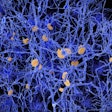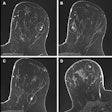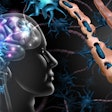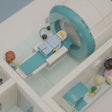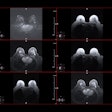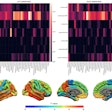CT and MR neuroimaging reveal covert brain infarcts and white-matter hyperintensity (WMH) changes that appear to be associated with increased fall risk, researchers have reported.
The two imaging findings can be indications of hidden cerebrovascular disease, which has been linked to future stroke, dementia, and higher mortality rates, wrote a team led by Úna Clancy, PhD, of the University of Edinburgh in the U.K. The findings were published June 27 in Stroke.
"Since [cerebrovascular disease] is highly prevalent, especially in advancing age, it is important to identify the full spectrum of clinical presentations and outcomes associated with [it]," the group explained. "This will allow us to clinically identify as many affected patients as possible, institute management strategies, communicate prognosis, plan healthcare delivery, and aid recruitment to treatment trials."
Covert brain infarcts and white-matter hyperintensities are often found incidentally on brain imaging in patients who haven't manifested typical stroke symptoms, and in addition to suggesting the presence of cerebrovascular disease, they can also indicate cerebral small vessel disease -- which has in turn been associated with neurophychiatric, cognitive, and gait symptoms (which may include falling) that don't necessarily fit the definition of stroke or dementia.
As the impact of covert brain infarcts and white-matter hyperintensities on fall risk in the general population isn't clear, Clancy and colleagues conducted a study that investigated the time to a first fall following incidentally detected covert brain infarcts and white-matter hyperintensities. Their research assessed CT and MR imaging results from 241,050 patients over the age of 50 registered with Kaiser Permanente Southern California. The team used natural language processing to cull evidence of covert brain infarcts and white-matter hyperintensities from imaging reports and tracked any associations between the two findings with falls requiring medical attention.
Overall, the investigators found covert brain infarcts in 31.1% of the study cohort over a follow-up of three years; 21.2% of patients had recorded falls during that timeframe. They also reported the following:
Single fall incidence rate per 1,000 person-years on CT and MR imaging | ||
Finding | CT | MRI |
Covert brain infarcts and white-matter hyperintensities | 129.3 falls per 1,000 person-years | 109.9 falls per 1,000 person-years |
White-matter hyperintensities | 109.9 falls per 1,000 person-years | 71.4 falls per 1,000 person-years |
The group noted that the adjusted hazard ratio (with one as reference) for a single index fall in individuals with covert brain infarcts was 1.13 on CT and 1.17 on MRI, and that patients' risk of fall increased when both covert brain infarcts and white-matter hyperintensities were identified on CT or MR imaging:
- The adjusted hazard ratio for a single index fall in individuals with covert brain infarcts on CT was 1.13 and 1.17 on MRI.
- On CT, the risk of a single index fall increased by white-matter hyperintensity severity, with an adjusted hazard ratio of 1.37 for mild white-matter hyperintensities and 1.57 for both moderate and severe.
- On MRI, index fall risk also increased with increasing white-matter hyperintensity severity, with an adjusted hazard ratio of 1.11 for mild, 1.21 for moderate, and 1.34 for severe.
"The presence of both [covert brain infarcts] and [white-matter hyperintensities] carries more than double the incidence rate of a single index fall versus no [covert brain infarcts/white-matter hyperintensities]," the team wrote.
The study findings could help not only to reduce healthcare costs but also to offer better care to aging patients, according to the authors.
"Falls are a major contributor to emergency unscheduled healthcare, and [cerebrovascular disease] is highly prevalent among older people on clinical neuroimaging," they concluded. "Our results show that the two are closely linked: when [covert brain infarcts] and [white-matter hyperintensities] are detected, this confers additional prognostic risk for future falls … Adding this knowledge to the clinical implications of [cerebrovascular disease] means that integrated care systems can better prognosticate and plan care for the high proportions of older adults who attend health services."
The complete study can be found here.




.fFmgij6Hin.png?auto=compress%2Cformat&fit=crop&h=100&q=70&w=100)

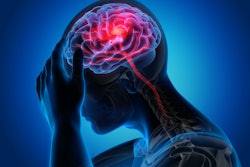


.fFmgij6Hin.png?auto=compress%2Cformat&fit=crop&h=167&q=70&w=250)


